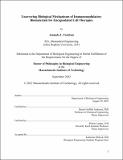Uncovering Biological Mechanisms of Immunomodulatory Biomaterials for Encapsulated Cell Therapies
Author(s)
Facklam, Amanda L.
DownloadThesis PDF (8.326Mb)
Advisor
Anderson, Daniel Griffith
Langer, Robert
Terms of use
Metadata
Show full item recordAbstract
Biomaterials are used in a variety of therapeutics including vaccines, engineered tissues, and cell therapies. Biomaterials enable a range of functionalities such as localized delivery, sustained release, and responsiveness. In the context of cell therapies, biomaterials can protect encapsulated cells from immune attack while allowing for nutrient and oxygen exchange. While this approach holds greats potential, the immune response to biomaterials remains a major challenge to the field. Upon implantation of a material, the immune system will initiate the foreign body response, a cascade of inflammatory activity resulting in material fibrosis. For encapsulated cell therapies, biomaterial fibrosis can result in diminished cell functionality or even cell death. To address this challenge, it is critical to design biomaterials which can modulate the host immune response to mitigate fibrosis. In this thesis, we characterize the effect of biomaterial properties on immune responses after implantation. First, we describe how physical properties of alginate capsules can affect the success of encapsulated cell therapy. We find that capsules with lower permeability to IgG and higher strength enable longer encapsulated islet cures in diabetic mice. Furthermore, we show that differences in islet cure lengths were largely dependent on differential capsule immune responses. Next, we describe the effects of E9, an anti-fibrotic biomaterial coating, on macrophage behavior. We find that E9 downregulates CD86 surface expression when immobilized on a biomaterial surface. In addition, E9 downregulates the secretion of several cytokines including MCP-1 and VEGF and upregulates the secretion of IL-1β from macrophages. Next, we describe our work identifying the functional protein targets of E9 to gain further insight into its mechanism of action. We find that Macrophage migration inhibitory factor and Thioredoxin bind E9 and may have roles in its anti-fibrotic activity. Through this work, we identify macrophage proteins and signaling pathways involved in the mechanism of action of E9, leading to an improved understanding of the foreign body response. Overall, by characterizing the effect of material properties on immune responses, we enable rational design of next-generation immunomodulatory biomaterials.
Date issued
2022-09Department
Massachusetts Institute of Technology. Department of Biological EngineeringPublisher
Massachusetts Institute of Technology